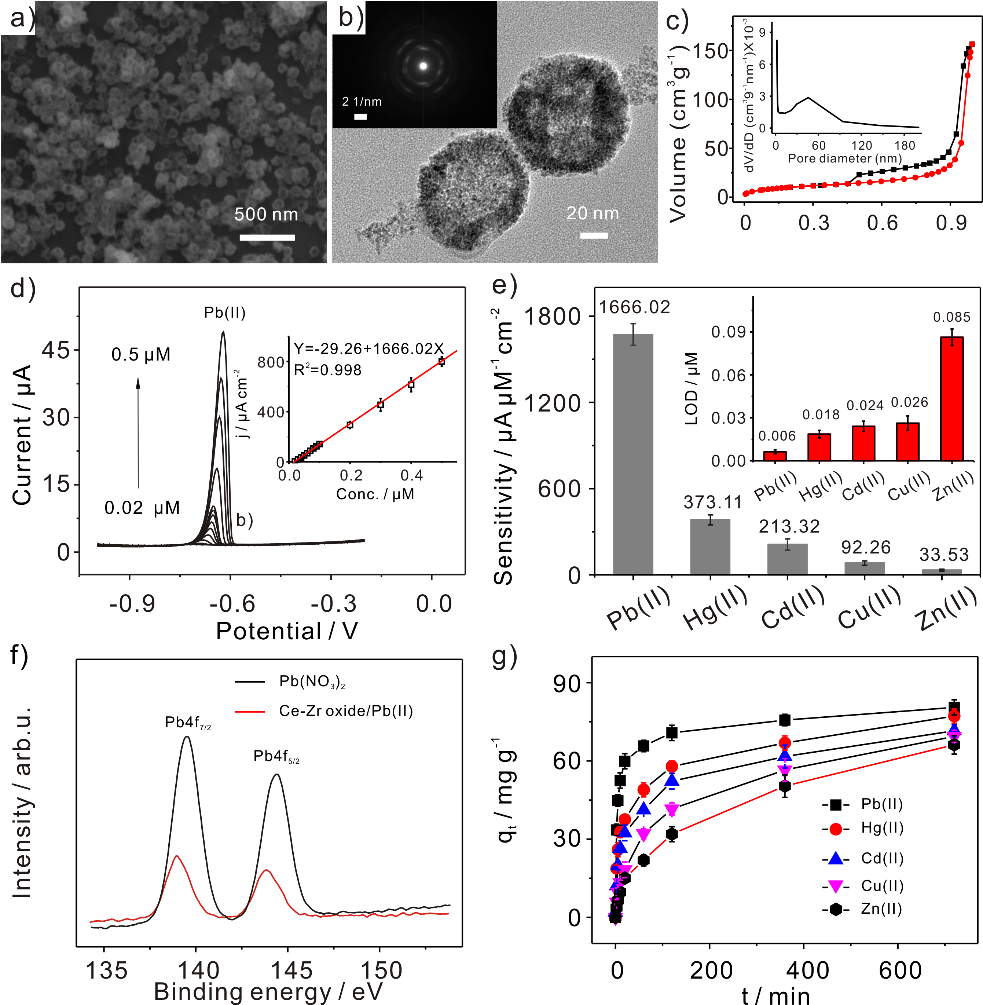Electrochemical analytical tools are widely applied to detect Pb(II), through which abundant achievements have been made. However, the mutual interference among the different heavy metal ions is serious due to the intermetallic compounds formed among them and the competition for the active sites at the modified electrode surface.
Grounded on this, it is problematic to accurately detect real water samples contaminated with Pb(II) in the presence of other common coexistence of heavy metal ions. Therefore, it is an electrochemical analytical challenge to realize the selective and sensitive detection of target analytes.
Recently, a study team led by Prof. HUANG Xingjiu in Institute of Intelligent Machines (IIM), Hefei Institutes of Physical Science, explored the sensitivity and selectivity sensing lead(II) using porous Ce-Zr oxide nanospheres. The study has been published in Sensors and Actuators B: Chemical.
In this work, researchers attempted to detect ultra-trace Pb(II) with a novel bimetallic oxide of porous Ce-Zr oxide nanospheres. Encouragingly, the selective and sensitive detection of Pb(II) was achieved in the presence of other common coexisting ions.
Notably, through a series of studies they found that Ce-Zr oxide nanospheres have a highest rate of adsorption for Pb(II), therefore, the detection of Pb(II) can achieve the highest selectively and sensitivity on the Ce-Zr oxide nanospheres modified electrode. The difference in the adsorption rates of Ce-Zr oxide nanospheres for heavy metal ions may be attributed to the difference of the adsorption energies and affinity.
Meanwhile, the analytical application of the proposed method toward the detection of Pb(II) in a wastewater collected from Wangtang sewage disposal plant in Hefei City, China, has been verified.
This finding provides a new insight into the use of binary oxide nanomaterials serving as modifiers for the sensitivity and selectivity detection of hazardous substances.
This work was supported by the National Natural Science Foundation of China (21475133, U1532123, 21377131, 61474122). X.-J. Huang acknowledges the CAS Interdisciplinary Innovation Team of the Chinese Academy of Sciences, and the CASHIPS Director’s Fund, Grant No. YZJJ201701, for financial support. (十日内)
Link to the paper: Sensitive and interference-free electrochemical determination of Pb(II) in wastewater using porous Ce-Zr oxide nanospheres

Figure 1. Morphologic structure and selectivity studies. a) and b) SEM and TEM image of the Ce-Zr oxide nanospheres, respectively. c) N2 adsorption-desorption isotherms and pore diameter distribution (inset) of the Ce-Zr oxidenanospheres.d) Typical SWASV signals of Ce-Zr oxide/GCE toward Pb(II). e) Comparisons of sensitivity and LOD (inset in panel) of HMIs with the Ce-Zr oxide /GCE. f)High-resolution XPS spectrum of Pb4fadsorbed on Ce-Zr oxide nanospheres. g) The relationship between adsorption time and adsorption capacity of Ce-Zr oxide nanospheres toward Pb(II), Hg(II), Cd(II), Cu(II), and Zn(II), respectively. (Image provided by YANG Meng)
Key words:Ce-Zr oxide nanospheres; Pb(II); interference-free; wastewater
Article link: http://www.sciencedirect.com/science/article/pii/S0925400517321925
Title: Sensitive and interference-free electrochemical determination of Pb(II) in wastewater using porous Ce-Zr oxide nanospheres
Prof. HUANG Xing-Jiu, Ph. DPrincipal Investigator
Institute of Intelligent Machines, Chinese Academy of Sciences
Hefei 230031, China
Tel: 86-551-6559-1167
Email: xingjiuhuang@iim.ac.cn
